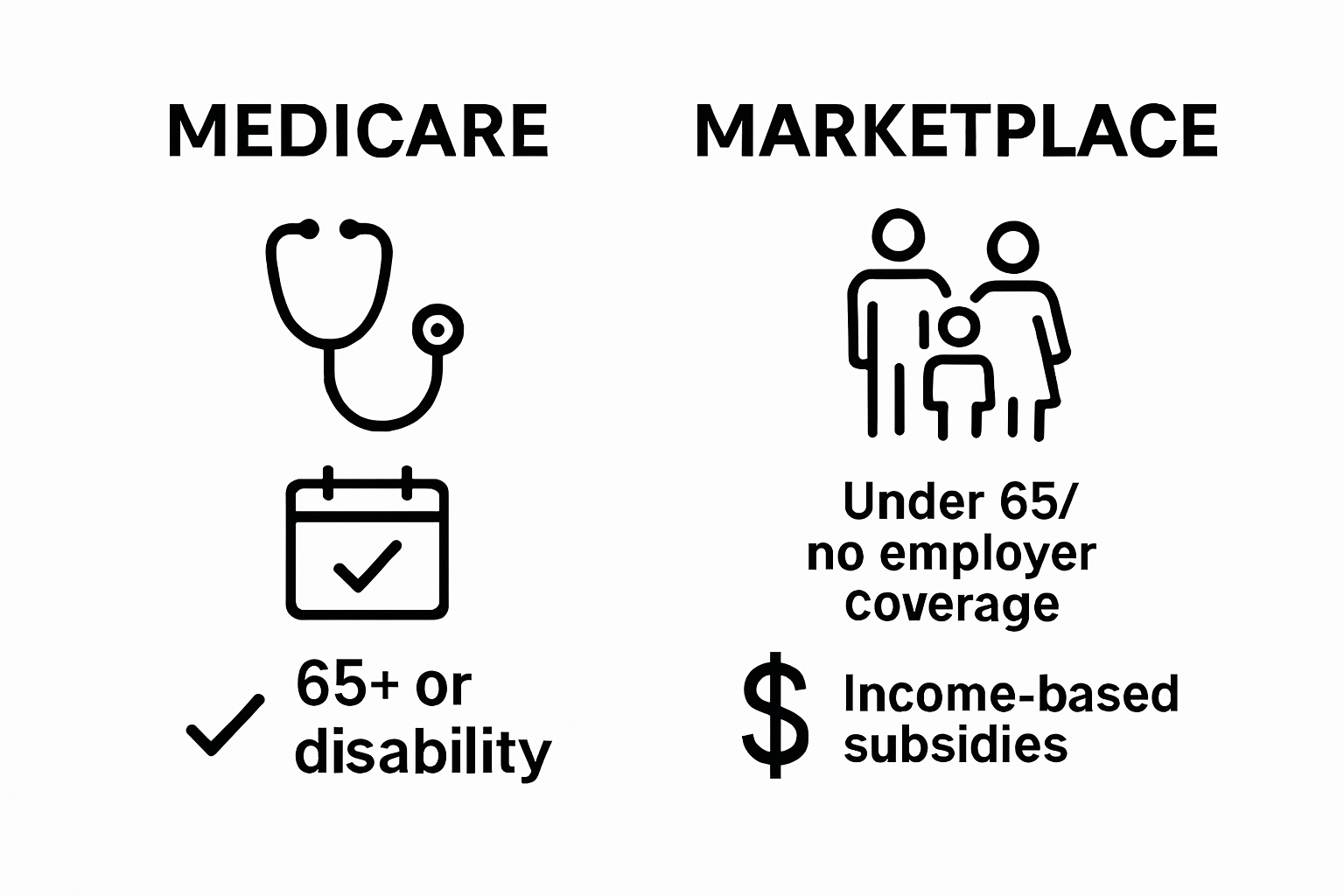Table of Contents
- Defining Medicare And Marketplace Insurance
- The Importance Of Medicare And Marketplace Options
- Key Differences Between Medicare And Marketplace Plans
- How Coverage Works In Medicare Vs Marketplace
- Considerations For Choosing Between Medicare And Marketplace
Quick Summary
| Takeaway | Explanation |
|---|---|
| Know the Medicare Parts | Medicare includes Parts A, B, C, and D for various health needs. |
| Marketplace Insurance Has Flexibility | Marketplace allows individuals to compare multiple plans with income-based help. |
| Eligibility Varies by Age and Coverage | Medicare is mainly for those 65+; Marketplace serves those under 65 without insurance. |
| Cost Structures Differ | Medicare generally has fixed costs, while Marketplace plans offer subsidies based on income. |
| Choose Based on Personal Needs | Evaluate your health status, finances, and future medical needs when selecting coverage. |
Defining Medicare and Marketplace Insurance
Health insurance can be complex, but understanding the fundamental differences between Medicare and Marketplace insurance is crucial for making informed healthcare decisions. These two distinct insurance systems serve different populations and offer unique coverage options.
What is Medicare?
Medicare is a federal health insurance program primarily designed for Americans aged 65 and older, as well as certain younger individuals with specific disabilities or medical conditions. Established in 1965, Medicare provides comprehensive health coverage through multiple parts:
- Part A: Hospital insurance covering inpatient stays
- Part B: Medical insurance for outpatient services and preventive care
- Part C: Medicare Advantage plans offered by private insurers
- Part D: Prescription drug coverage
Understanding Marketplace Insurance
Marketplace insurance represents health coverage available through the Affordable Care Act (ACA) exchanges. These plans are designed for individuals and families who do not qualify for Medicare, Medicaid, or employer-sponsored health insurance. Learn more about ACA coverage options.
Key characteristics of Marketplace insurance include:
- Standardized essential health benefit requirements
- Income-based subsidies and tax credits
- Coverage for pre-existing conditions
- Options to compare multiple plans across different metal tiers
The primary difference between Medicare and Marketplace insurance lies in their target populations and funding mechanisms. Medicare is a government-administered program primarily serving seniors and disabled individuals, while Marketplace insurance provides a competitive platform for private insurers to offer coverage to the general population.
The Importance of Medicare and Marketplace Options
Navigating health insurance requires understanding how Medicare and Marketplace options protect individuals and families at different stages of life. Each system plays a critical role in ensuring accessible and affordable healthcare coverage across diverse population segments.
Financial Protection and Healthcare Access
Research from the Kaiser Family Foundation reveals that Medicare provides essential health coverage to over 60 million Americans, helping older adults and people with disabilities manage healthcare costs. The significance of these insurance options extends far beyond basic medical coverage.
Key financial protections include:
- Preventing catastrophic medical expenses
- Enabling access to preventive care services
- Reducing out-of-pocket healthcare costs
- Protecting vulnerable populations from financial hardship
Comprehensive Healthcare Choices
Both Medicare and Marketplace insurance offer unique advantages that cater to different demographic needs. Understand how to maximize your healthcare coverage by exploring the nuanced benefits of each system.
Marketplace plans provide flexibility for working-age individuals, while Medicare ensures comprehensive coverage for seniors and disabled populations. The diverse range of plans allows individuals to select coverage that best matches their specific health requirements and financial circumstances.
Important considerations when selecting health insurance include:
- Individual health needs and medical history
- Budget and affordability
- Prescription drug requirements
- Preferred healthcare providers and network restrictions
Ultimately, understanding the importance of Medicare and Marketplace options empowers individuals to make informed decisions about their healthcare coverage, ensuring they receive appropriate medical support throughout different life stages.
Key Differences Between Medicare and Marketplace Plans
Understanding the nuanced differences between Medicare and Marketplace plans is crucial for making informed healthcare decisions. While both systems aim to provide comprehensive health coverage, they operate with distinct structures, eligibility requirements, and benefits.
Eligibility and Target Populations
Research from the Centers for Medicare and Medicaid Services highlights the fundamental distinctions in target populations. Medicare primarily serves seniors aged 65 and older, as well as certain younger individuals with disabilities, while Marketplace plans cater to working-age individuals and families who do not qualify for Medicare or employer-sponsored insurance.
Key eligibility differences include:

- Medicare: Age 65+ or specific disability qualifications
- Marketplace: Open to individuals under 65 without other comprehensive coverage
- Income considerations: Marketplace offers subsidies based on household income
- Enrollment periods: Different sign-up windows for each system
Cost Structure and Financial Considerations
Compare Medicare and ACA plans online to understand the unique cost structures. Medicare typically involves:
- Premiums for Part B and Part D
- Potential supplemental insurance costs
- Deductibles and copayments based on coverage type
Marketplace plans, in contrast, offer:
- Income-based premium subsidies
- Standardized metal tier pricing
- More flexible plan selection
- Potential out-of-pocket cost assistance
The most significant difference lies in how these plans are funded and administered.
The following table clarifies the key differences between Medicare and Marketplace insurance in several essential categories to support readers in evaluating which option may fit their needs best.
| Feature | Medicare | Marketplace Insurance |
|---|---|---|
| Target Population | Primarily age 65+ and certain younger individuals with disabilities | Individuals and families under 65 without other coverage |
| Administration | Federal government | Private insurers via state/federal ACA exchanges |
| Coverage Structure | Parts A (Hospital), B (Medical), C (Advantage), D (Drugs) | Metal tiers (Bronze, Silver, Gold, Platinum) |
| Eligibility Requirements | Age 65+, certain disabilities or conditions | No employer-sponsored, Medicare, or Medicaid; income-based subsidies |
| Cost Structure | Fixed premiums, deductibles, copayments; limited subsidies | Income-based premiums, tax credits, cost-sharing assistance |
| Enrollment Periods | Initial, Special, and General Enrollment periods | Open Enrollment and Special Enrollment Periods |
| Provider Network | Wide, especially with traditional Medicare; some restrictions with Advantage | Plan-specific networks; must select covered providers |
How Coverage Works in Medicare vs Marketplace
Navigation of health insurance requires understanding the intricate mechanisms behind Medicare and Marketplace coverage. While both systems aim to provide comprehensive healthcare protection, their operational frameworks differ significantly in structure, enrollment, and benefit delivery.
Medicare Coverage Mechanics
According to Medicare.gov, Medicare offers a structured approach to healthcare coverage through multiple interconnected parts. The coverage framework includes:
- Part A: Hospital insurance covering inpatient services
- Part B: Outpatient medical services and preventive care
- Part C: Medicare Advantage plans from private insurers
- Part D: Prescription medication coverage
Medicare beneficiaries can customize their coverage by selecting different combinations of these parts, allowing for tailored healthcare protection that meets individual medical needs.
This table summarizes the core components and coverage features of Medicare0Parts, providing a quick reference for what each part offers and who provides the coverage.
| Medicare Part | What It Covers | Who Provides It |
|---|---|---|
| Part A | Inpatient hospital care | Federal government |
| Part B | Outpatient/medical services | Federal government |
| Part C | All-in-one plans (A, B, usually D) | Private insurers |
| Part D | Prescription drug coverage | Private insurers |
Marketplace Insurance Coverage Approach
Learn more about Marketplace plan details to understand the comprehensive coverage options. Marketplace plans operate differently, offering standardized coverage across multiple metal tier levels:
- Bronze: Lower premiums, higher out-of-pocket costs
- Silver: Moderate premiums and cost-sharing
- Gold: Higher premiums, lower out-of-pocket expenses
- Platinum: Highest premiums, lowest personal healthcare costs
Unlike Medicare, Marketplace plans provide income-based subsidies and maintain consistent essential health benefit requirements across all participating insurance providers. This approach ensures a baseline of coverage while offering flexibility in plan selection.
The fundamental difference lies in how these systems distribute healthcare costs and manage risk. Medicare uses a federal government model with standardized benefits, while Marketplace plans leverage private insurance competition to provide diverse coverage options tailored to individual needs.
Considerations for Choosing Between Medicare and Marketplace
Selecting the most appropriate health insurance requires careful evaluation of personal health needs, financial circumstances, and individual eligibility. Understanding the critical factors that differentiate Medicare and Marketplace plans helps individuals make informed healthcare coverage decisions.
Personal Health and Financial Assessment
Evaluating your unique healthcare requirements involves analyzing multiple dimensions beyond basic coverage. Key personal factors include:
- Current health status and anticipated medical needs
- Annual healthcare expenses and budget constraints
- Prescription medication requirements
- Preferred healthcare providers and network restrictions
Legal and Enrollment Implications
Healthcare.gov warns that individuals must carefully navigate enrollment transitions to avoid potential financial penalties. Critical considerations include:
- Medicare eligibility timelines
- Potential subsidy discontinuation
- Mandatory enrollment periods
- Penalties for delayed Medicare registration
Strategic Coverage Selection
Explore comprehensive plan comparisons to determine the most suitable option. The decision between Medicare and Marketplace plans depends on several strategic factors:
- Age and disability status
- Current employment and insurance coverage
- Income level and potential subsidies
- Long-term healthcare goals
Ultimately, the choice between Medicare and Marketplace insurance is not universal but deeply personal. Individuals must assess their specific circumstances, weighing factors such as comprehensive coverage, cost-effectiveness, and alignment with their healthcare needs and financial capabilities.

Ready for Guidance on Medicare and Marketplace Decisions?
Trying to choose between Medicare and Marketplace options is overwhelming. There are so many parts and plan types, shifting enrollment windows, and the fear that picking the wrong plan could lead to lost coverage or unnecessary expenses. If you find yourself confused about eligibility, differences in coverage, or how enrollment periods work, you are not alone. Many people feel anxious about these choices because making a mistake can carry real financial consequences. For those nearing retirement or already planning ahead, it is crucial to have a reliable partner to guide you each step of the way. Visit our Medicare & Seniors-Insurance Agents section to explore professional resources tailored to your unique situation.

Discover how GenerationHealth.me can take the confusion out of comparing Medicare vs Marketplace solutions. Our experts help you break down every part so you can enroll confidently and quickly. Get instant quotes, personalized plan comparisons, and support with every step. Do not risk missing enrollment deadlines or overpaying for your coverage. Get started today and secure the right plan for your needs.
Frequently Asked Questions
What is the main difference between Medicare and Marketplace insurance?
Medicare is a federal program primarily for individuals aged 65 and older or those with certain disabilities, while Marketplace insurance is designed for working-age individuals and families who do not qualify for Medicare or employer-sponsored insurance.
Who is eligible for Medicare?
Eligibility for Medicare includes individuals aged 65 and older, as well as certain younger individuals with disabilities or specific medical conditions.
How do the costs of Medicare compare to Marketplace insurance?
Medicare typically involves premiums for Part B and Part D, along with copayments and deductibles. Marketplace insurance may offer income-based subsidies and a variety of premium options across different metal tiers, allowing for more flexible pricing.
Can I switch from Marketplace insurance to Medicare?
Yes, individuals can transition from Marketplace insurance to Medicare during the open enrollment period. However, it’s important to be aware of eligibility timelines and potential penalties for not enrolling in Medicare during the designated period.
Recommended
- Understanding Eligibility for ACA Marketplace Coverage – GenerationHealth.Me Your Online Health Insurance Marketplace
- GenerationHealth.me-Compare Medicare & ACA Plans Online | Marketplace – GenerationHealth.Me Your Online Health Insurance Marketplace
- How to Maximize Medicare Coverage for Optimal Health – GenerationHealth.Me Your Online Health Insurance Marketplace